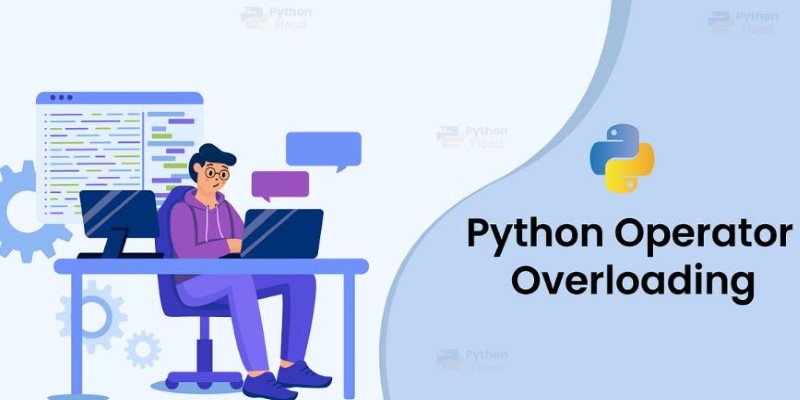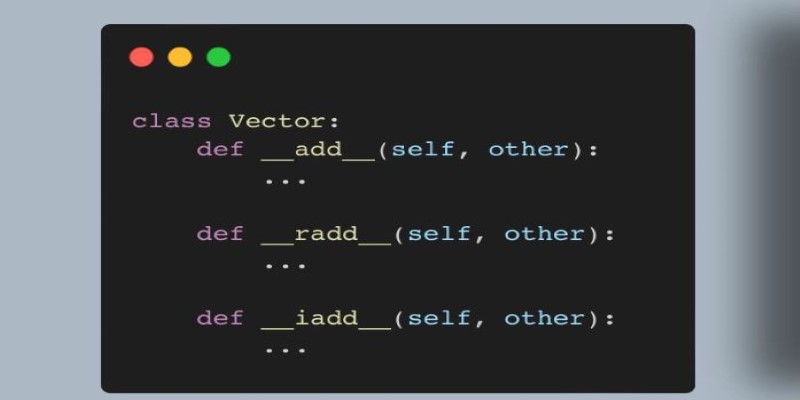Advertisement
If you've been working with Python for a while, you've probably used operators like +, -, *, and others without thinking twice. Add two numbers, and it works. Multiply two variables, and it does what you expect. But what happens when you try to add two custom objects? That's where operator overloading steps in. It lets you define how built-in operators behave with your own classes. So, instead of raising errors, your objects start behaving like numbers, strings, or even lists—if that's what you want.
Operator overloading allows objects to answer operators naturally. When you add using +, Python doesn't simply add; it invokes a method behind the scenes. For integers, it invokes __add__. For strings, it invokes __add__ but with a different action—concatenation. The same applies to your own classes. You can specify how +, -, ==, <, [], and even function calls should act.
So, when someone writes a + b, they’re not just adding two things—they’re triggering a method on the object a. If a is an instance of your class, and you've defined the __add__ method, then Python uses that. No tricks involved, just Python being open to customization.
Because sometimes your objects should behave more like built-in types. Think of a vector. You’d want to add two vectors like this: v1 + v2, not v1.add(v2). It’s not just shorter—it’s more readable. You want code that feels right to the person reading it.

Operator overloading doesn’t just make things prettier. It keeps your logic cleaner. Instead of calling .multiply() or .equals() every time, you just use * or ==. Less noise, more meaning.
And the best part? You only write the logic once—inside the method. After that, using the operator just works.
Let’s look at what you can actually do. Python gives you access to many special methods—sometimes called dunder methods because of their double underscores. Here are some you’ll likely use:
Each one lets you define what happens when two objects are combined in that way. You just return a new object—or whatever makes sense—from that method.
These are helpful when your object has an internal value, like a number or a score. You can decide what makes two objects equal—or which one is greater.
Python doesn’t hold back. If something’s possible with built-in types, chances are you can recreate that same behavior with your custom class.

Let’s walk through a simple example to see how all of this works. We’ll build a basic Point class that represents a coordinate on a 2D grid.
python
CopyEdit
class Point:
def __init__(self, x, y):
self.x = x
self.y = y
You start by giving it two values: x and y. At this stage, it’s just a container for those values. It doesn’t do anything fancy yet—but it’s enough to hold data.
Now, let's add some behavior. You want to be able to add two points using the + operator. For that, you define the __add__ method:
python
CopyEdit
def __add__(self, other):
return Point(self.x + other.x, self.y + other.y)
With this in place, you can do something like p1 + p2, and instead of throwing a TypeError, Python will return a new Point with summed coordinates. It feels just like adding two numbers, and that’s the whole idea.
To make the output more readable when you print a Point, it helps to overload the __str__ method too:
python
CopyEdit
def __str__(self):
return f"({self.x}, {self.y})"
Now, if you print the result of p1 + p2, you won't see a cryptic object reference, but you'll see something meaningful, like coordinates.
Here’s how it all comes together:
python
CopyEdit
p1 = Point(2, 3)
p2 = Point(4, 1)
print(p1 + p2) # Output: (6, 4)
It works exactly how you'd expect. And you're not limited to just addition. You could define subtraction and comparison, or you could even use square brackets to make it behave like a list. If your object supports it and improves readability, you can build that logic. Python gives you that freedom.
You might be wondering—should everything use operator overloading? The short answer is no. Just because you can doesn’t mean you should. If your object naturally maps to a built-in type, then yes, it’s a great fit. Vectors, matrices, custom strings, numeric containers—these are all solid candidates.
But if your object’s behavior doesn’t match any intuitive operator, forcing it will just confuse whoever reads your code. Imagine overloading * to send an email. That’s just weird. Stick to what feels logical. So, if an operator makes your code more intuitive—do it. If it introduces a surprise—skip it.
Python doesn't just give you tools—it gives you freedom. Operator overloading is one of those features that makes the language feel like it gets out of your way. Instead of writing clunky methods, you can describe your logic in a way that's clean, short, and readable. The next time you're building a class, and you find yourself writing .add(), .equals(), or .multiply(), ask yourself—could this just be +, ==, or *? Chances are, the answer is yes. And if it is, now you know how to make it happen.
Advertisement

The IBM z15 empowers businesses with cutting-edge capabilities for hybrid cloud integration, data efficiency, and scalable performance, ensuring optimal solutions for modern enterprises.

Work doesn’t have to be a grind. Discover how CrewAI and Groq help you design agentic workflows that think, adapt, and deliver—freeing you up for bigger wins

Follow these essential steps to build a clean AI data set using Getty Images for effective and accurate machine learning models

Wondering how databases stay connected and make sense? Learn how foreign keys link tables together, protect data, and keep everything organized

Want to run LLaMA 3 on your own machine? Learn how to set it up locally, from hardware requirements to using frameworks like Hugging Face or llama.cpp

Learn how the SQL SELECT statement works, why it's so useful, and how to run smarter queries to grab exactly the data you need without the extra clutter

How an AI assistant is transforming last-mile deliveries by improving efficiency, reducing costs, and enhancing customer satisfaction through smarter routing and coordination

Discover how generative AI for the artist has evolved, transforming creativity, expression, and the entire artistic journey

Snowflake introduces its new text-embedding model, optimized for Retrieval-Augmented Generation (RAG). Learn how this enterprise-grade model outperforms others and improves data processing

How Georgia Tech is transforming supply chain management with AI through education, research, and partnerships, creating smarter and more resilient global networks

An exploration of Cerebras' advancements in AI hardware, its potential impact on the industry, and how it challenges established competitors like Nvidia.

Curious how Tableau actually uses AI to make data work better for you? This article breaks down practical features that save time, spot trends, and simplify decisions—without overcomplicating anything